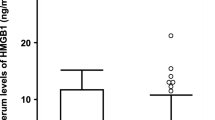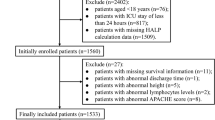Abstract
Purpose
Cytotoxic chemotherapy-induced lung injury is a fatal complication in patients with lung cancer and interstitial lung disease (ILD). We aimed to evaluate the association between hyperglycemia and this form of lung injury in patients with lung cancer concomitant with ILD.
Methods
From 1147 patients with advanced lung cancer, we retrospectively enrolled 98 patients with ILD whose hemoglobin A1c (HbA1c) levels were measured, and investigated the association between HbA1c levels and cytotoxic chemotherapy-induced lung injury. In 73 patients whose serum samples were retained, we measured serum levels of advanced glycation end products (AGE) and assessed the association of AGE levels with HbA1c levels and cytotoxic chemotherapy-induced lung injury.
Results
The incidence of cytotoxic chemotherapy-induced lung injury was significantly higher in patients with HbA1c levels ≥ 5.8% than in those with HbA1c levels < 5.8%, but not in those with HbA1c levels ≥ 6.5% than in those with HbA1c levels < 6.5%. The multivariate logistic regression model revealed that HbA1c level ≥ 5.8% was a significant risk factor for this complication [odds ratio 3.178 (95% confidence interval 1.057–9.556), P = 0.040]. In addition, serum AGE levels were significantly higher in patients with HbA1c levels ≥ 5.8% than in those with HbA1c levels < 5.8% [median (interquartile range); 0.129 (0.023–0.290) and 0.474 (0.213–1.109) μg/mL, P = 0.001].
Conclusion
Glucose intolerance (e.g., HbA1c level ≥ 5.8%) may be a risk factor of cytotoxic chemotherapy-induced lung injury, which might be associated with elevated AGE production due to hyperglycemia.



Similar content being viewed by others
References
Chen CM, Juan SH, Pai MH, Chou HC (2018) Hyperglycemia induces epithelial-mesenchymal transition in the lungs of experimental diabetes mellitus. Acta Histochem 120:525–533. https://doi.org/10.1016/j.acthis.2018.06.004
Enomoto T, Usuki J, Azuma A, Nakagawa T, Kudoh S (2003) Diabetes mellitus may increase risk for idiopathic pulmonary fibrosis. Chest 123:2007–2011. https://doi.org/10.1378/chest.123.6.2007
Hu Y, Ma Z, Guo Z, Zhao F, Wang Y, Cai L, Yang J (2014) Type 1 diabetes mellitus is an independent risk factor for pulmonary fibrosis. Cell Biochem Biophys 70:1385–1391. https://doi.org/10.1007/s12013-014-0068-4
Davis WA, Knuiman M, Kendall P, Grange V, Davis TM, Fremantle Diabetes Study (2004) Glycemic exposure is associated with reduced pulmonary function in type 2 diabetes: the Fremantle Diabetes Study. Diabetes Care 27:752–757. https://doi.org/10.2337/diacare.27.3.752
Litonjua AA, Lazarus R, Sparrow D, Demolles D, Weiss ST (2005) Lung function in type 2 diabetes: the Normative Aging Study. Respir Med 99:1583–1590. https://doi.org/10.1016/j.rmed.2005.03.023
McKeever TM, Weston PJ, Hubbard R, Fogarty A (2005) Lung function and glucose metabolism: an analysis of data from the Third National Health and Nutrition Examination Survey. Am J Epidemiol 161:546–556. https://doi.org/10.1093/aje/kwi076
Walter RE, Beiser A, Givelber RJ, O’Connor GT, Gottlieb DJ (2003) Association between glycemic state and lung function: the Framingham Heart Study. Am J Respir Crit Care Med 167:911–916. https://doi.org/10.1164/rccm.2203022
Yeh HC, Punjabi NM, Wang NY, Pankow JS, Duncan BB, Cox CE, Selvin E, Brancati FL (2008) Cross-sectional and prospective study of lung function in adults with type 2 diabetes: the Atherosclerosis Risk in Communities (ARIC) study. Diabetes Care 31:741–746. https://doi.org/10.2337/dc07-1464
Alarcon GS, Kremer JM, Macaluso M, Weinblatt ME, Cannon GW, Palmer WR, St Clair EW, Sundy JS, Alexander RW, Smith GJ, Axiotis CA (1997) Risk factors for methotrexate-induced lung injury in patients with rheumatoid arthritis. A multicenter, case-control study. Methotrexate-Lung Study Group. Ann Intern Med 127:356–364. https://doi.org/10.7326/0003-4819-127-5-199709010-00003
Nakao S, Yamaguchi K, Sakamoto S, Horimasu Y, Masuda T, Miyamoto S, Nakashima T, Iwamoto H, Fujitaka K, Hamada H, Hattori N (2019) Chemotherapy-associated acute exacerbation of interstitial lung disease shortens survival especially in small cell lung cancer. Anticancer Res 39:5725–5731. https://doi.org/10.21873/anticanres.13773
Kenmotsu H, Naito T, Kimura M, Ono A, Shukuya T, Nakamura Y, Tsuya A, Kaira K, Murakami H, Takahashi T, Endo M, Yamamoto N (2011) The risk of cytotoxic chemotherapy-related exacerbation of interstitial lung disease with lung cancer. J Thorac Oncol 6:1242–1246. https://doi.org/10.1097/JTO.0b013e318216ee6b
Isobe K, Hata Y, Sakamoto S, Takai Y, Shibuya K, Homma S (2010) Clinical characteristics of acute respiratory deterioration in pulmonary fibrosis associated with lung cancer following anti-cancer therapy. Respirology 15:88–92. https://doi.org/10.1111/j.1440-1843.2009.01666.x
Minegishi Y, Kokuho N, Miura Y, Matsumoto M, Miyanaga A, Noro R, Saito Y, Seike M, Kubota K, Azuma A, Kida K, Gemma A (2014) Clinical features, anti-cancer treatments and outcomes of lung cancer patients with combined pulmonary fibrosis and emphysema. Lung Cancer 85:258–263. https://doi.org/10.1016/j.lungcan.2014.05.016
Enomoto Y, Inui N, Kato T, Baba T, Karayama M, Nakamura Y, Ogura T, Suda T (2016) Low forced vital capacity predicts cytotoxic chemotherapy-associated acute exacerbation of interstitial lung disease in patients with lung cancer. Lung Cancer 96:63–67. https://doi.org/10.1016/j.lungcan.2016.03.017
Nakao S, Yamaguchi K, Iwamoto H, Sakamoto S, Horimasu Y, Masuda T, Miyamoto S, Nakashima T, Ohshimo S, Fujitaka K, Hamada H, Hattori N (2020) Serum high-mobility group box 1 as a predictive marker for cytotoxic chemotherapy-induced lung injury in patients with lung cancer and interstitial lung disease. Respir Med 172:106131. https://doi.org/10.1016/j.rmed.2020.106131
Katakami N (2018) Mechanism of development of atherosclerosis and cardiovascular disease in diabetes mellitus. J Atheroscler Thromb 25:27–39. https://doi.org/10.5551/jat.RV17014
Basta G (2008) Receptor for advanced glycation endproducts and atherosclerosis: from basic mechanisms to clinical implications. Atherosclerosis 196:9–21. https://doi.org/10.1016/j.atherosclerosis.2007.07.025
Kilhovd BK, Giardino I, Torjesen PA, Birkeland KI, Berg TJ, Thornalley PJ, Brownlee M, Hanssen KF (2003) Increased serum levels of the specific AGE-compound methylglyoxal-derived hydroimidazolone in patients with type 2 diabetes. Metabolism 52:163–167. https://doi.org/10.1053/meta.2003.50035
Aso Y, Inukai T, Tayama K, Takemura Y (2000) Serum concentrations of advanced glycation endproducts are associated with the development of atherosclerosis as well as diabetic microangiopathy in patients with type 2 diabetes. Acta Diabetol 37:87–92. https://doi.org/10.1007/s005920070025
Machahua C, Montes-Worboys A, Llatjos R, Escobar I, Dorca J, Molina-Molina M, Vicens-Zygmunt V (2016) Increased AGE-RAGE ratio in idiopathic pulmonary fibrosis. Respir Res 17:144. https://doi.org/10.1186/s12931-016-0460-2
Hirose A, Tanikawa T, Mori H, Okada Y, Tanaka Y (2010) Advanced glycation end products increase endothelial permeability through the RAGE/Rho signaling pathway. FEBS Lett 584:61–66. https://doi.org/10.1016/j.febslet.2009.11.082
Goldstraw P, Chansky K, Crowley J, Rami-Porta R, Asamura H, Eberhardt WE, Nicholson AG, Groome P, Mitchell A, Bolejack V, International Association for the Study of Lung Cancer S, Prognostic Factors Committee AB Participating I, International Association for the Study of Lung Cancer S, Prognostic Factors Committee Advisory B Participating I (2016) The IASLC lung cancer staging project: proposals for revision of the TNM Stage Groupings in the Forthcoming (Eighth) Edition of the TNM Classification for Lung Cancer. J Thorac Oncol 11:39–51. https://doi.org/10.1016/j.jtho.2015.09.009
Raghu G, Remy-Jardin M, Myers JL, Richeldi L, Ryerson CJ, Lederer DJ, Behr J, Cottin V, Danoff SK, Morell F, Flaherty KR, Wells A, Martinez FJ, Azuma A, Bice TJ, Bouros D, Brown KK, Collard HR, Duggal A, Galvin L, Inoue Y, Jenkins RG, Johkoh T, Kazerooni EA, Kitaichi M, Knight SL, Mansour G, Nicholson AG, Pipavath SNJ, Buendia-Roldan I, Selman M, Travis WD, Walsh S, Wilson KC, American Thoracic Society ERSJRS, Latin American Thoracic S (2018) Diagnosis of idiopathic pulmonary fibrosis. An official ATS/ERS/JRS/ALAT clinical practice guideline. Am J Respir Crit Care Med 198:e44–e68. https://doi.org/10.1164/rccm.201807-1255ST
International Expert C (2009) International Expert Committee report on the role of the A1C assay in the diagnosis of diabetes. Diabetes Care 32:1327–1334. https://doi.org/10.2337/dc09-9033
Committee of the Japan Diabetes Society on the Diagnostic Criteria of Diabetes M, Seino Y, Nanjo K, Tajima N, Kadowaki T, Kashiwagi A, Araki E, Ito C, Inagaki N, Iwamoto Y, Kasuga M, Hanafusa T, Haneda M, Ueki K (2010) Report of the committee on the classification and diagnostic criteria of diabetes mellitus. J Diabetes Investig 1:212–228. https://doi.org/10.1111/j.2040-1124.2010.00074.x
Schmidt AM, Hori O, Chen JX, Li JF, Crandall J, Zhang J, Cao R, Yan SD, Brett J, Stern D (1995) Advanced glycation endproducts interacting with their endothelial receptor induce expression of vascular cell adhesion molecule-1 (VCAM-1) in cultured human endothelial cells and in mice. A potential mechanism for the accelerated vasculopathy of diabetes. J Clin Invest 96:1395–1403. https://doi.org/10.1172/JCI118175
Miyoshi A, Koyama S, Sasagawa-Monden M, Kadoya M, Konishi K, Shoji T, Inaba M, Yamamoto Y, Koyama H (2019) JNK and ATF4 as two important platforms for tumor necrosis factor-alpha-stimulated shedding of receptor for advanced glycation end products. FASEB J 33:3575–3589. https://doi.org/10.1096/fj.201701553RR
Wang D, Ma Y, Tong X, Zhang Y, Fan H (2020) Diabetes mellitus contributes to idiopathic pulmonary fibrosis: a review from clinical appearance to possible pathogenesis. Front Public Health 8:196. https://doi.org/10.3389/fpubh.2020.00196
Suzuki A, Taniguchi H, Kondoh Y, Ando M, Watanabe N, Kimura T, Kataoka K, Yokoyama T, Sakamoto K, Hasegawa Y (2017) Soluble thrombomodulin in bronchoalveolar lavage fluid is an independent predictor of severe drug-induced lung injury. Respirology 22:744–749. https://doi.org/10.1111/resp.12965
Minegishi Y, Takenaka K, Mizutani H, Sudoh J, Noro R, Okano T, Azuma A, Yoshimura A, Ando M, Tsuboi E, Kudoh S, Gemma A (2009) Exacerbation of idiopathic interstitial pneumonias associated with lung cancer therapy. Intern Med 48:665–672. https://doi.org/10.2169/internalmedicine.48.1650
Kikuchi R, Takoi H, Tsuji T, Nagatomo Y, Tanaka A, Kinoshita H, Ono M, Ishiwari M, Toriyama K, Kono Y, Togashi Y, Yamaguchi K, Yoshimura A, Abe S (2021) Glasgow Prognostic Score predicts chemotherapy-triggered acute exacerbation-interstitial lung disease in patients with non-small cell lung cancer. Thorac Cancer 12:667–675. https://doi.org/10.1111/1759-7714.13792
Cai X, Zhang Y, Li M, Wu JH, Mai L, Li J, Yang Y, Hu Y, Huang Y (2020) Association between prediabetes and risk of all cause mortality and cardiovascular disease: updated meta-analysis. BMJ 370:m2297. https://doi.org/10.1136/bmj.m2297
Welsh C, Welsh P, Celis-Morales CA, Mark PB, Mackay D, Ghouri N, Ho FK, Ferguson LD, Brown R, Lewsey J, Cleland JG, Gray SR, Lyall DM, Anderson JJ, Jhund PS, Pell JP, McGuire DK, Gill JMR, Sattar N (2020) Glycated hemoglobin, prediabetes, and the links to cardiovascular disease: data from UK Biobank. Diabetes Care 43:440–445. https://doi.org/10.2337/dc19-1683
Cai X, Liu X, Sun L, He Y, Zheng S, Zhang Y, Huang Y (2021) Prediabetes and the risk of heart failure: A meta-analysis. Diabetes Obes Metab. 23:1746–1753. https://doi.org/10.1111/dom.14388
American Diabetes A (2021) 2. Classification and diagnosis of diabetes: standards of medical care in diabetes-2021. Diabetes Care 44:S15–S33. https://doi.org/10.2337/dc21-S002
Acknowledgements
We would like to thank Editage (www.editage.com) for English language editing.
Funding
This work was supported by JSPS KAKENHI (grant number 18K15951).
Author information
Authors and Affiliations
Contributions
TO: validation, formal analysis, investigation, resources, data curation, writing—original draft, visualization. KY: conceptualization, methodology, formal analysis, resources, writing—review and editing. NS: validation, formal analysis, investigation, resources, data curation, writing—review and editing. SS: resources, writing—review and editing. YH: resources, writing—review and editing. TM: resources, writing—review and editing. SM: resources, writing—review and editing. TN: resources, writing—review and editing. HI: resources, writing—review and editing. KF: resources, writing—review and editing. HH: resources, writing—review and editing, supervision. NH: resources, writing—review and editing, supervision, project administration.
Corresponding author
Ethics declarations
Conflict of interest
The authors declare that they have no conflict of interest.
Ethical approval
This study was approved by the Ethics Committee of Hiroshima University Hospital (E-2242 and M326).
Consent to participate
The opt-out method was used to obtain participant’s consent. The participants who provided stored serum samples also provided written informed consent before the samples were obtained.
Data availability
Data will be made available on reasonable request.
Additional information
Publisher's Note
Springer Nature remains neutral with regard to jurisdictional claims in published maps and institutional affiliations.
Supplementary Information
Below is the link to the electronic supplementary material.
Rights and permissions
About this article
Cite this article
Otani, T., Yamaguchi, K., Nakao, S. et al. Association between glucose intolerance and chemotherapy-induced lung injury in patients with lung cancer and interstitial lung disease. Cancer Chemother Pharmacol 88, 857–865 (2021). https://doi.org/10.1007/s00280-021-04341-y
Received:
Accepted:
Published:
Issue Date:
DOI: https://doi.org/10.1007/s00280-021-04341-y




